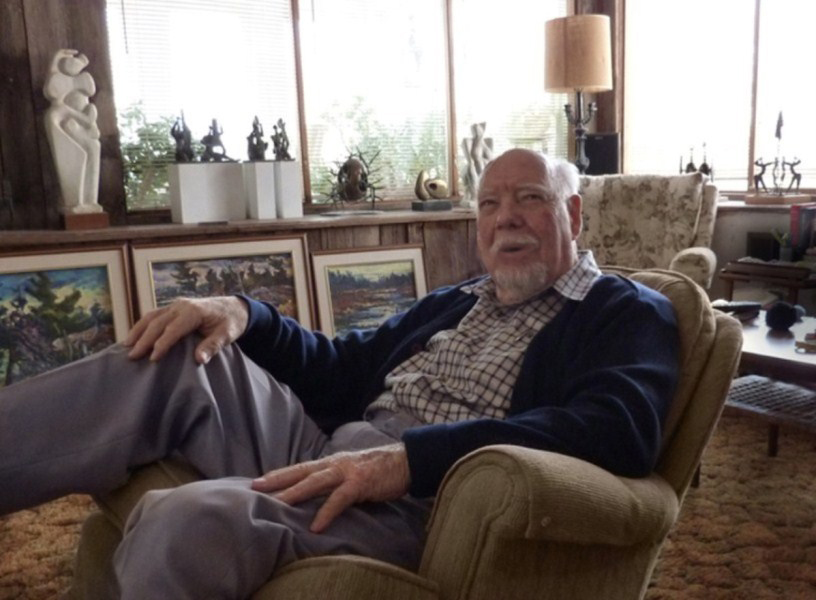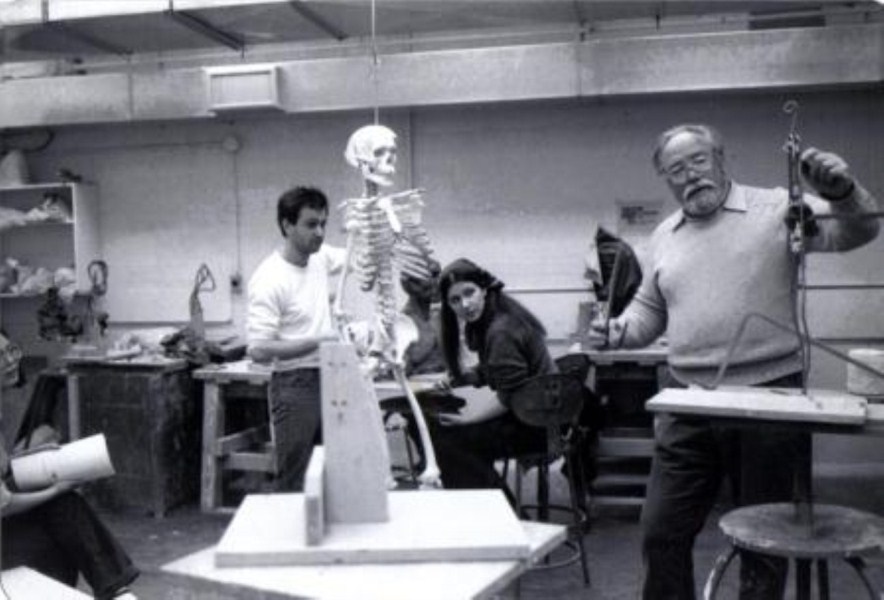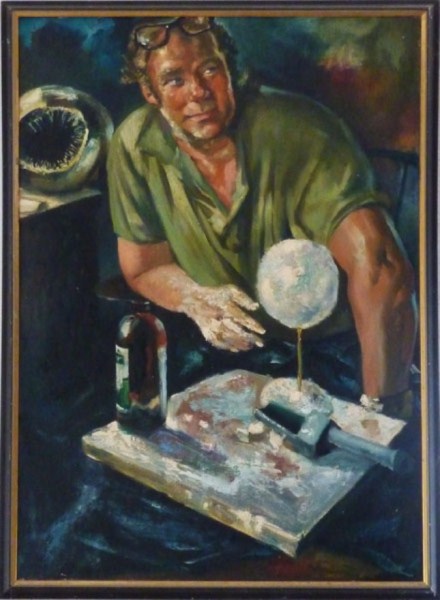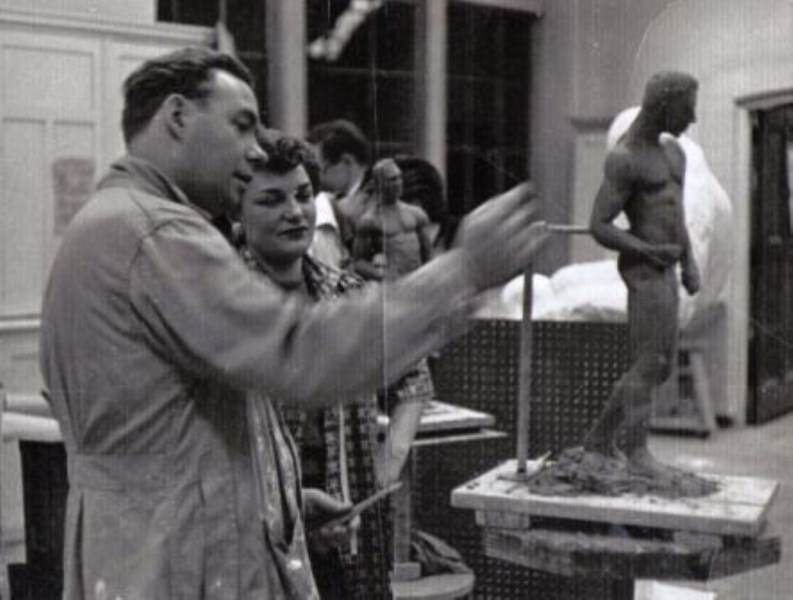William Albert Clements, first generation Canadian, was born in Toronto in 1921, only child to Harold and Jenny (Jean) Clements. They were a blue collar family from Northern England and he learned from them to always be honest, trustworthy, respectful of his betters and never aspire to go above his station.
As a child he was not exposed to any positive association with art or artists, and was actually discouraged from doing anything so "useless and sissified". In school he showed exceptional talent in drawing from an early age but was slow in academic subjects. The fact that he was severely dyslexic was not known, and was especially frustrating to him. And he was left handed, a trait that teachers tried to beat out of him with the result that he became ambidextrous, ultimately a great advantage in sculpting. He himself says he was a chronic dreamer; one teacher in particular tried to change him by administering the strap to his open hands each morning and afternoon and would have continued if not for the day when his mother witnessed this "punishment" and put a stop to it! It was not until he was in his final year of elementary school that he surprised his teacher by getting an above average mark; he was the quintessential late bloomer. This same teacher, making predictions about his students' futures - suggesting to each child in turn: Banker, Salesman, Business man, etc. - came to Bill and just shook his head and said "I don't know what's going to become of you!".
Bill's parents were pleased when he got a job as a plumber's assistant, hoping that this would lead to a useful occupation. But he wanted to be an artist and began attending evening classes in drawing and painting. In 1941, after a succession of factory jobs, he joined the Royal Canadian Navy. During his service he continued to draw and paint, and made paintings of their wives for other sailors, taking classes whenever he had a shore posting. On his first leave home he married the girl he had left behind, Grace Ridout, and they are still together.
When Bill was discharged from the Navy, the Department of Veteransí Affairs offered credits towards buying a house and acreage or the chance to continue education. Even though he now had a family, he chose to take the opportunity to attend the Ontario College of Art and pursue his long held dream.
In his own words "It became the vehicle for my dreams - being schooled by professional artists. The college was flooded with vets like myself all attempting to make up for lost opportunities; this time at O.C.A. was hectic with many personality clashes between instructors and students. To survive I worked harder than ever at every subject and my life awakened." For the first time he was exposed to real artists. Not until he got into an art school where text was not as important as pictures and shapes did he shine. There, for the first time in his life, he was top of the class. His particular favorite professor was Emmanuel Hahn, sculptor of the Ned Hanlon Memorial on Toronto's waterfront and designer of Canada's 10 cent and 25 cent coins. Bill graduated with First Class Honours in 1949 in sculpture.
After graduating, he worked as a designer with McNeill-Taylor (display & industrial designs). He also worked as assistant to renowned Canadian sculptor Jacobine Jones, working on many architectural projects including the large figures that can be seen on the front of the Archives Building, University of Toronto; the huge relief and other sculpture on the Bank of Nova Scotia at King and Bay Streets in Toronto; and on the B. A. Oil Building (since demolished) in Toronto; he assisted Cleeve Horne on his portrait of Alexander Graham Bell and worked with his former classmate William McElcheren on many of his works.
Bill was teaching evening classes in sculpture at Central Technical School, Toronto when the department head, Peter Haworth, suggested that he should apply to University of Toronto College of Education for a teaching degree. He faced the same problem with dyslexia as he had as a child but with perseverance and dedication he succeeded. He obtained a position as art teacher at Danforth Technical School in Toronto.
Bill taught sculpture for seventeen years at Danforth Technical School, Central Technical School, and the alternate school Three Schools, in Toronto. He enjoyed teaching but gradually tired of the school system atmosphere. After a yearís sabbatical on half pay he put in one more year then retired at age 52. The steady income had been necessary when he was providing for his growing family, but now he wanted to devote himself to his own work.
However, in 1980 Bill was asked to become an instructor of Fine Art Sculpture at the Ontario College of Art and did so until 1989. Several of his former students are now professional sculptors and credit his instruction and encouragement in their success.
In 1976 Bill moved to Prince Edward County and undertook the construction of a house and studio that he designed himself, built on the foundation of an old barn. (When Bill and Grace were young teenagers they saw a house on Kingston Road, east of Toronto that was built on a stone barn foundation. What a great idea! How romantic! Never dreaming that they might one day be able to build one for themselves.)
Bill liked the idea of his studio and home being one and designed the studio to encompass the whole lower level, a mezzanine and an airy space with a twenty foot ceiling. He built it with the help of his son-in-law and fellow sculptor Ray Mackintosh and nephew Gary Ridout, using some of the beams and boards rescued from the original barn. The house includes a round leaded window made by his daughter Louise, a spiral staircase he made with the help of his son Ted, and many other unique features including a chandelier made from a farm rake and other found objects. Bill also put up a large building to store implements and to accommodate the foundry that he had always wanted. Here he has melted and poured small bronze sculptures using equipment that he developed himself.
On the walls are paintings by his friends Donald G. Fraser; A. D.(Dan) Logan; Sigmund Serafin; former student Helena Borody; and his daughter Jeannie Mackintosh; prints by Vernon Mould; Marven Swartz; there is sculpture by William McElcheran; and many of Billís own pieces of course.
Bill and Grace had five children; Richard, Christine, Ted, Louise, and Jeannie. Bill always wanted to be an artist but he never chose to follow any course that would exclude his being a present and caring husband and father. He encouraged Grace in whatever she chose to do - when she learned bookbinding and repair, he built her some of the equipment needed and offered advice which she gladly accepted. He always supported his children in their chosen careers. Rick is a business executive; Christine, now retired, was a high school teacher and librarian; Ted is a successful yacht designer; Louise works in the film industry as a special make-up artist and special effects designer along with her husband Raymond; Jeannie is a Communications Coordinator at McMaster University.
All of them are in long-lasting marriages, following their parentsí example, and there are fourteen grandchildren and now a dozen great grandchildren. So far only a few of their offspring have chosen a career in art, including Suzanne Clements and Rosalie Mackintosh, but all have an appreciation of and some measure of talent in the arts. Other grandchildren are: Science Editor at Voice of America; head of a high school science department; principal of a high school for native children in N.W.T.; two nurse practitioners; a language specialist teaching in South Korea; a mechanical engineering consultant.
A biography of Bill would not be complete without mentioning Billís love of everything Spanish. He wanted to study a foreign language and concluded that Spanish would be the easiest. He began taking classes in conversational Spanish over 30 years ago, and continued his study until he was past 87, only stopping when his class was cancelled in 2009. But he keeps working at it and studies his many textbooks. He watches Spanish programming whenever possible and he and Grace have visited Spain, Cuba and Mexico several times. He loves the people, the places, the music and the food.
Prince Edward County has become an artists community in recent years. Bill was pleased when his friend, sculptor Wyndham Lawrence bought a home nearby. And he has made new friends like artist Dennis Poitras whom he mentored, and Don Alexander who had a gallery in Wellington where he showed and sold some of Billís work; and all of his neighbours in the county.
Bill is a great cook and is famous for his fresh baked bread of all kinds, his cheese cookies, mouth-watering stews and casseroles. He and Grace have not bought baked goods since their children were young.
Bill would certainly have made more money if he had stuck to plumbing as a career, but he would never have been happy, and his family and students would not have had his rich and caring influence.
As a child he was not exposed to any positive association with art or artists, and was actually discouraged from doing anything so "useless and sissified". In school he showed exceptional talent in drawing from an early age but was slow in academic subjects. The fact that he was severely dyslexic was not known, and was especially frustrating to him. And he was left handed, a trait that teachers tried to beat out of him with the result that he became ambidextrous, ultimately a great advantage in sculpting. He himself says he was a chronic dreamer; one teacher in particular tried to change him by administering the strap to his open hands each morning and afternoon and would have continued if not for the day when his mother witnessed this "punishment" and put a stop to it! It was not until he was in his final year of elementary school that he surprised his teacher by getting an above average mark; he was the quintessential late bloomer. This same teacher, making predictions about his students' futures - suggesting to each child in turn: Banker, Salesman, Business man, etc. - came to Bill and just shook his head and said "I don't know what's going to become of you!".
Bill's parents were pleased when he got a job as a plumber's assistant, hoping that this would lead to a useful occupation. But he wanted to be an artist and began attending evening classes in drawing and painting. In 1941, after a succession of factory jobs, he joined the Royal Canadian Navy. During his service he continued to draw and paint, and made paintings of their wives for other sailors, taking classes whenever he had a shore posting. On his first leave home he married the girl he had left behind, Grace Ridout, and they are still together.
When Bill was discharged from the Navy, the Department of Veteransí Affairs offered credits towards buying a house and acreage or the chance to continue education. Even though he now had a family, he chose to take the opportunity to attend the Ontario College of Art and pursue his long held dream.
In his own words "It became the vehicle for my dreams - being schooled by professional artists. The college was flooded with vets like myself all attempting to make up for lost opportunities; this time at O.C.A. was hectic with many personality clashes between instructors and students. To survive I worked harder than ever at every subject and my life awakened." For the first time he was exposed to real artists. Not until he got into an art school where text was not as important as pictures and shapes did he shine. There, for the first time in his life, he was top of the class. His particular favorite professor was Emmanuel Hahn, sculptor of the Ned Hanlon Memorial on Toronto's waterfront and designer of Canada's 10 cent and 25 cent coins. Bill graduated with First Class Honours in 1949 in sculpture.
After graduating, he worked as a designer with McNeill-Taylor (display & industrial designs). He also worked as assistant to renowned Canadian sculptor Jacobine Jones, working on many architectural projects including the large figures that can be seen on the front of the Archives Building, University of Toronto; the huge relief and other sculpture on the Bank of Nova Scotia at King and Bay Streets in Toronto; and on the B. A. Oil Building (since demolished) in Toronto; he assisted Cleeve Horne on his portrait of Alexander Graham Bell and worked with his former classmate William McElcheren on many of his works.
Bill was teaching evening classes in sculpture at Central Technical School, Toronto when the department head, Peter Haworth, suggested that he should apply to University of Toronto College of Education for a teaching degree. He faced the same problem with dyslexia as he had as a child but with perseverance and dedication he succeeded. He obtained a position as art teacher at Danforth Technical School in Toronto.
Bill taught sculpture for seventeen years at Danforth Technical School, Central Technical School, and the alternate school Three Schools, in Toronto. He enjoyed teaching but gradually tired of the school system atmosphere. After a yearís sabbatical on half pay he put in one more year then retired at age 52. The steady income had been necessary when he was providing for his growing family, but now he wanted to devote himself to his own work.
However, in 1980 Bill was asked to become an instructor of Fine Art Sculpture at the Ontario College of Art and did so until 1989. Several of his former students are now professional sculptors and credit his instruction and encouragement in their success.
In 1976 Bill moved to Prince Edward County and undertook the construction of a house and studio that he designed himself, built on the foundation of an old barn. (When Bill and Grace were young teenagers they saw a house on Kingston Road, east of Toronto that was built on a stone barn foundation. What a great idea! How romantic! Never dreaming that they might one day be able to build one for themselves.)
Bill liked the idea of his studio and home being one and designed the studio to encompass the whole lower level, a mezzanine and an airy space with a twenty foot ceiling. He built it with the help of his son-in-law and fellow sculptor Ray Mackintosh and nephew Gary Ridout, using some of the beams and boards rescued from the original barn. The house includes a round leaded window made by his daughter Louise, a spiral staircase he made with the help of his son Ted, and many other unique features including a chandelier made from a farm rake and other found objects. Bill also put up a large building to store implements and to accommodate the foundry that he had always wanted. Here he has melted and poured small bronze sculptures using equipment that he developed himself.
On the walls are paintings by his friends Donald G. Fraser; A. D.(Dan) Logan; Sigmund Serafin; former student Helena Borody; and his daughter Jeannie Mackintosh; prints by Vernon Mould; Marven Swartz; there is sculpture by William McElcheran; and many of Billís own pieces of course.
Bill and Grace had five children; Richard, Christine, Ted, Louise, and Jeannie. Bill always wanted to be an artist but he never chose to follow any course that would exclude his being a present and caring husband and father. He encouraged Grace in whatever she chose to do - when she learned bookbinding and repair, he built her some of the equipment needed and offered advice which she gladly accepted. He always supported his children in their chosen careers. Rick is a business executive; Christine, now retired, was a high school teacher and librarian; Ted is a successful yacht designer; Louise works in the film industry as a special make-up artist and special effects designer along with her husband Raymond; Jeannie is a Communications Coordinator at McMaster University.
All of them are in long-lasting marriages, following their parentsí example, and there are fourteen grandchildren and now a dozen great grandchildren. So far only a few of their offspring have chosen a career in art, including Suzanne Clements and Rosalie Mackintosh, but all have an appreciation of and some measure of talent in the arts. Other grandchildren are: Science Editor at Voice of America; head of a high school science department; principal of a high school for native children in N.W.T.; two nurse practitioners; a language specialist teaching in South Korea; a mechanical engineering consultant.
A biography of Bill would not be complete without mentioning Billís love of everything Spanish. He wanted to study a foreign language and concluded that Spanish would be the easiest. He began taking classes in conversational Spanish over 30 years ago, and continued his study until he was past 87, only stopping when his class was cancelled in 2009. But he keeps working at it and studies his many textbooks. He watches Spanish programming whenever possible and he and Grace have visited Spain, Cuba and Mexico several times. He loves the people, the places, the music and the food.
Prince Edward County has become an artists community in recent years. Bill was pleased when his friend, sculptor Wyndham Lawrence bought a home nearby. And he has made new friends like artist Dennis Poitras whom he mentored, and Don Alexander who had a gallery in Wellington where he showed and sold some of Billís work; and all of his neighbours in the county.
Bill is a great cook and is famous for his fresh baked bread of all kinds, his cheese cookies, mouth-watering stews and casseroles. He and Grace have not bought baked goods since their children were young.
Bill would certainly have made more money if he had stuck to plumbing as a career, but he would never have been happy, and his family and students would not have had his rich and caring influence.

William A. Clements, RCA, AOCA
Biography




Bill at home, 2009
Portrait of Bill by A.D.Logan which hangs in Bill's home.
Teaching night school in the '50s
Teaching at OCA in the eighties
Bill and Grace on the road in front of their house in Prince Edward County, 2008
"I considered it a great privilege to have met and been taught by Bill Clements. He laid the foundation for my art career and was the kind of teacher I tried to model myself after when I began teaching. "
- Jack Taylor, Art Instructor at Sheridan College
- Jack Taylor, Art Instructor at Sheridan College